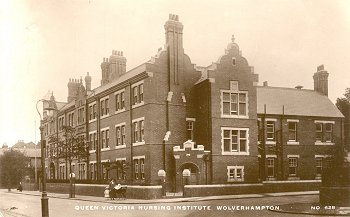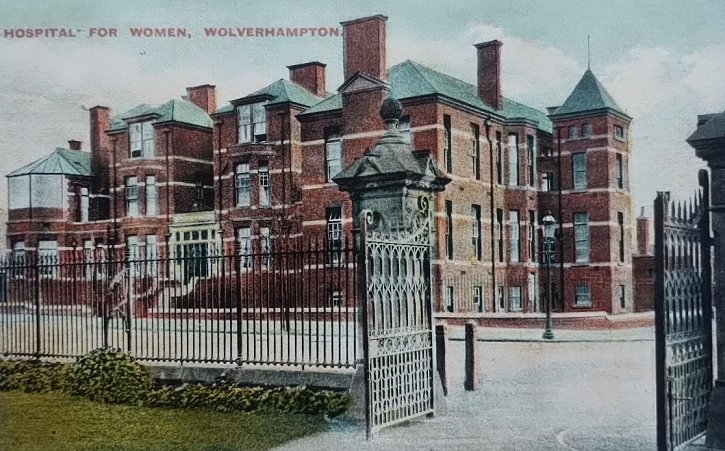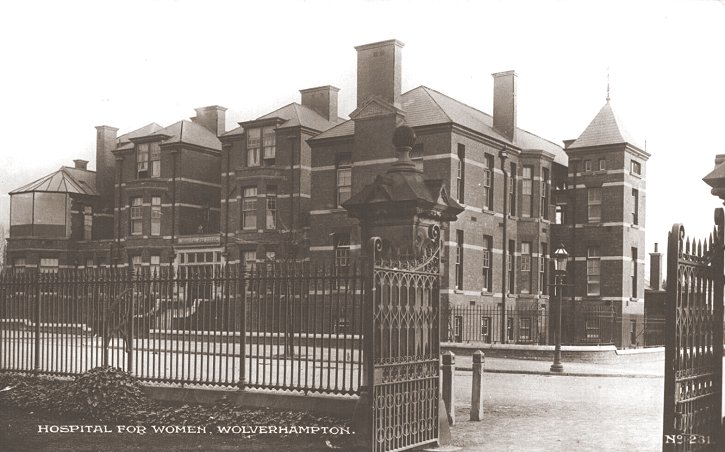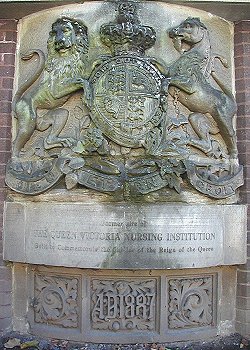|

|
Throughout the whole of the Victorian era
medical appointments to the Voluntary Hospitals were of an
honorary nature. Whilst most doctors of this period were
financially self-supporting, the necessity to earn money was
obvious. In this respect they supplied their skills and surgery
to the local businessmen and families in their homes. This type
of work attracted many medical men and the provision of private
hospitals in the late Victorian period also provided them with
extra earnings.
The Queen Victoria Nursing Institute began as
one of these hospitals. Initially a property was rented in
Clifton Terrace, Chapel Ash, to provide an in-house facility, in
1887.
In addition a small team of nurses were recruited to
provide their services to the local gentry, but it was soon
obvious that this facility was too small. It was under the
tutelage of Alderman T. Vincent Jackson, the first medical man
to become Mayor of Wolverhampton. Monies were sought and raised
and a request made to Queen Victoria to found a private hospital
in her name to celebrate the Jubilee year of 1887, thus
providing a permanent memorial of her reign.
|

| The letter that was
received by the council giving the Queen's consent for the
use of her name for the new hospital. |
|
With reference to your application of the
12th ultimo for permission to make use of Her
Majesty’s name in connection with a Nursing Institution which
the Town Council of Wolverhampton propose to erect in
commemoration of Her Majesty’s Jubilee, I am directed by the
Secretary of State to acquaint you that he has laid the same
before the Queen, and that Her Majesty has been graciously
pleased to accede to the request of the Town Council, and to
sanction the proposed Institution being called ‘The Queen
Victoria Nursing Institution’. |
| Her consent was given and the institution opened its
doors in 1895 at the Bath Road site, aided by additional money from
the Town Council. Some 20 plus beds and an operating theatre and
facilities were provided. Additionally it was decided that a labour
suite would also be available for private births.
The hospital was an instant success and within 18 years the
unit doubled in size, partially thanks to the sum of £20,000,
which was raised by local business. The extensions, which
included an enlarged kitchen with refrigerators and meal lift,
were installed. |

The new building in Bath Road. |
| Maid’s and surgeon’s rooms were provided plus a
small garden at the rear with stores for coal, wood and vegetables.
The total nursing staff was now 50, which included a domiciliary
force to care for the poor and sick in their homes, a forerunner
scheme for District Nursing. |
 |
Income was generated by private income from patients
plus charitable donations and bequests. Such was its status
that it became recognised by the Central Midwifery Board for the
training of midwifery staff.
The selection of Matron for such an establishment was always an
august procedure and both maid and living accommodation were
provided for her in addition to her salary of £70 per annum in
1907. |
| The Board of Governors, all with honorary titles,
were drawn from the prominent businessmen and clergy from
Wolverhampton. It was noted that several of these gave services to
the town hospitals.
During the First World War there is evidence that wounded
officers from the Staffordshire Regiments were treated there.
Between the war years the hospital continued to flourish, with
its 43 beds on 3 floors being occupied by an average of 1300
patients in the course of one year. The number of operations
performed ran at a similar pace. |
|
New X-ray and maternity facilities were provided
and the operating theatre re-furbished. Particularly evident
amongst the patients throughout these years, and into the 50s
and 60s, were the number of Wolves footballers receiving
cartilage operations.
With the advent of the NHS in 1948 the hospital
came under the auspices of the Royal Hospital but continued to
raise private money from its patients. Attending doctors still
received the accepted remuneration fees for their services. With
the hospital being built-in by the expanding Banks’ Brewery and
with the advent of the ring road, money was raised in the
business and charitable sectors for the provision of a new
Nuffield Hospital sited in Wood Road, Tettenhall, in the grounds
of the home of a former member of the Mander family. In 1978
this scheme was completed and the hospital opened its doors to
the demise of the Queen Victoria Nursing Institute.
|

Another view of the hospital.
|

From an old postcard.

From an old postcard.
|

The plaque in the brewery wall. |
The Bath Road site continued to be used for
the provision of Dermatology clinics until it was purchased by
Banks’ Brewery in the mid 1980s.
Thus ended a 100 year history of private
medical provision for the citizens of Wolverhampton. The only
remnant of its presence is the original foundation stone which
can be found in the wall of Banks’ Brewery in Bath Road.
Roy Stallard. T.D. |
 |
Return to
the
health section |
|